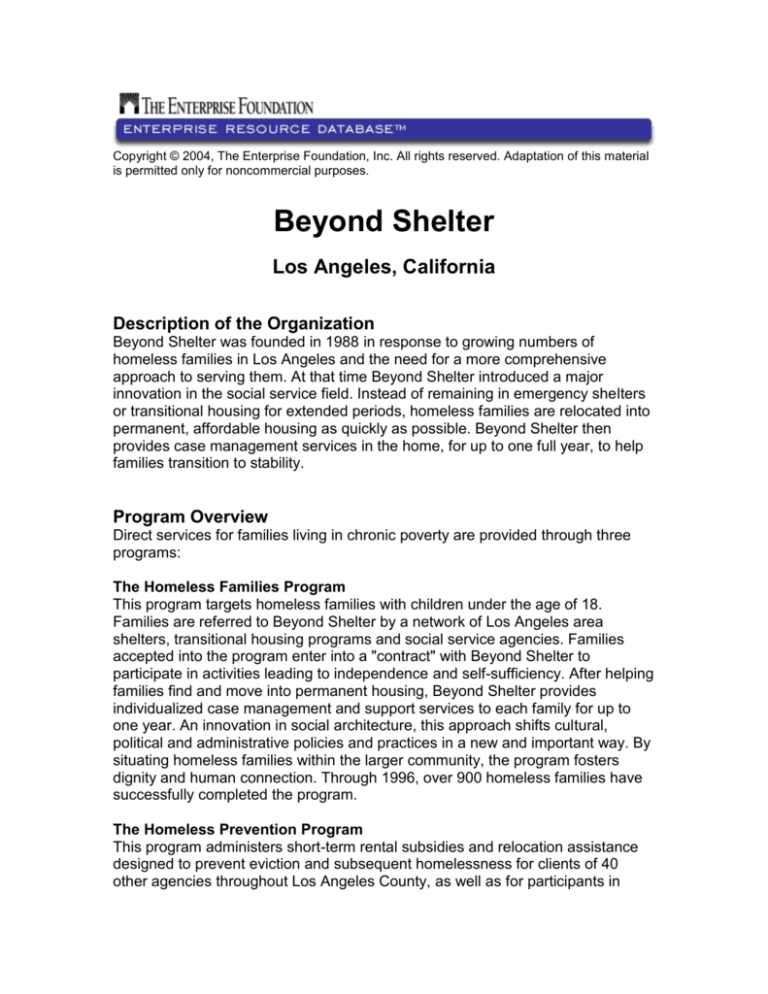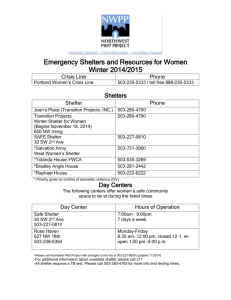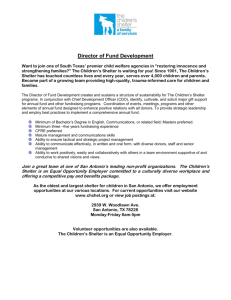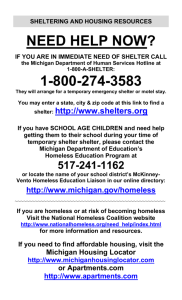
Copyright © 2004, The Enterprise Foundation, Inc. All rights reserved. Adaptation of this material
is permitted only for noncommercial purposes.
Beyond Shelter
Los Angeles, California
Description of the Organization
Beyond Shelter was founded in 1988 in response to growing numbers of
homeless families in Los Angeles and the need for a more comprehensive
approach to serving them. At that time Beyond Shelter introduced a major
innovation in the social service field. Instead of remaining in emergency shelters
or transitional housing for extended periods, homeless families are relocated into
permanent, affordable housing as quickly as possible. Beyond Shelter then
provides case management services in the home, for up to one full year, to help
families transition to stability.
Program Overview
Direct services for families living in chronic poverty are provided through three
programs:
The Homeless Families Program
This program targets homeless families with children under the age of 18.
Families are referred to Beyond Shelter by a network of Los Angeles area
shelters, transitional housing programs and social service agencies. Families
accepted into the program enter into a "contract" with Beyond Shelter to
participate in activities leading to independence and self-sufficiency. After helping
families find and move into permanent housing, Beyond Shelter provides
individualized case management and support services to each family for up to
one year. An innovation in social architecture, this approach shifts cultural,
political and administrative policies and practices in a new and important way. By
situating homeless families within the larger community, the program fosters
dignity and human connection. Through 1996, over 900 homeless families have
successfully completed the program.
The Homeless Prevention Program
This program administers short-term rental subsidies and relocation assistance
designed to prevent eviction and subsequent homelessness for clients of 40
other agencies throughout Los Angeles County, as well as for participants in
Beyond Shelter programs. These "rent to prevent eviction programs" allow
families to remain in their permanent housing and get back on their feet while
resolving a crisis which might lead to homelessness, such as loss of a job, a
medical emergency, or an incident of domestic violence. All program participants
receive case management from either Beyond Shelter or the referring agency for
a minimum of three months after relocation.
The Job Development Program
This program is based on Beyond Shelter’s efforts to motivate heads of
households in formerly homeless and/or welfare-dependent families to participate
in job training and job placement programs. Beyond Shelter continues to refine
its methodology and, upon funding, plans to implement its two-year
demonstration project, From Welfare to Work: Addressing the Needs of MultiProblem Families, with the subsequent production of a methodology manual of
the same title.
Other Social Services
In addition to providing direct services to families, Beyond Shelter develops and
operates service-enriched affordable housing through its Housing Development
Department and disseminates information on its methodologies through its
Technical Assistance Department. Beyond Shelter currently employs 35 full-time
staff persons and has an annual operating budget of approximately $1.5 million.
From 1995-1997, Beyond Shelter participated in "Moving to Opportunity," a fivecity HUD research project studying the long-term effect of moving families from
public housing projects to low poverty neighborhoods. Beyond Shelter assisted
100 families in locating and moving to appropriate housing in low-poverty census
tracts and provided support services for up to one year after the move.
The agency also coordinates the Emergency Food and Shelter Rent Assistance
Program for Los Angeles County, and serves as the Central Coordinating
Agency for the Short-Term Rent Assistance Program for Housing Opportunities
for People with AIDS (HOPWA).
Technical Assistance
From its inception, Beyond Shelter has encouraged the replication and
adaptation of its programs by other nonprofit and governmental organizations.
The Technical Assistance Department was initiated in 1991 under a two-year
demonstration grant from the Seaver Institute. The demonstration project
developed the Beyond Shelter Homeless Families Program for national
replication, and the resulting methodology manual has been disseminated
nationally. Subsequent foundation grants have enabled the Technical Assistance
Department to initiate a series of national workshops, presentations and
consultations to expand its training and dissemination curricula for agencies
seeking to adapt Beyond Shelter’s methodologies in their own communities. Most
2
recently, the focus has been in the area of service-enriched affordable housing.
The agency also publishes manuals and other materials including:
Beyond Housing Methodology Manual (1992), a step-by-step guide to adapting
Beyond Shelter’s program for homeless families, which essentially bypasses
completely or limits transitional housing and instead moves homeless families
directly to permanent housing with transitional support. (First edition funded by
the Seaver Institute; second edition funded by the Seaver Institute and the Soref
Foundation.) (158 pages.)
Family Survival Guide (first edition, 1991; revised edition, 1995), a life skills and
household management guide given to all participant families in either English or
Spanish to help them improve their parenting and housekeeping skills,
understand tenant and landlord roles and responsibilities, and improve access to
and utilization of neighborhood and community resources and services. This 95page publication has been adapted by agencies in many states.
Successful Household Money Management (1993), a 50-page curriculum manual
for teaching low-income families and individuals the basics of money
management. Funded and distributed by Bank of America Consumer Education
Fund.
In development for publication in 1997 are the following manuals:
Service-Enriched Housing: Models and Methodologies presents material
developed for dissemination at Beyond Shelter’s national workshops on serviceenriched permanent housing. Funding for development and initial printing of the
manual has been provided by the ARCO Foundation and the Ahmanson
Foundation.
The Safety Net: Accessing Community Resources for Low-Income Families is a
manual providing information on accessing resources and services in the
community, including how to overcome barriers to services, how to develop
services where none exist, and how to identify the service needs of different
populations. It also discusses client advocacy and strategies for changing the
system.
Tenant Responsibilities Manual, including renters’ rights and responsibilities,
eviction prevention, repair and maintenance obligations of property owners, what
to do with problem neighbors, and creating a friendly environment.
Housing Development Department
Beyond Shelter’s Housing Development Department was created to demonstrate
another new methodology: service-enriched housing. Service-enriched housing
represents an innovative and systemic change in confronting the long-term
3
needs of families and individuals caught in chronic poverty. The agency has
promoted the term "service-enriched housing" to help differentiate what is
essentially basic rental housing for the low income population-at-large -- not
necessarily at risk and not necessarily with special needs.
Beyond Shelter has created three demonstration models of service-enriched
housing. The agency’s housing projects include supportive services provided by
an on-site Beyond Shelter services coordinator. The coordinator oversees the
provision of crisis intervention and case management services, including job
training and child care, with the goal of helping families achieve self-sufficiency.
Parenting education and other adult education programs are available, as are
tutoring and enrichment activities for children. The services coordinator also
supports resident participation in management through Resident Management
Committees, which assist in management issues as well as coordinating and
developing activities and programs for residents. Service-enriched housing
allows for resident involvement in issues that affect their lives and the
environment in which they live.
Beyond Shelter’s service-enriched housing developments include:
Coronado Place Apartments
A 41-unit low-income housing project in the MacArthur Park area of Los Angeles.
Coronado Place is a renovated slum building in a neighborhood plagued by drug
dealers, prostitutes, and gangs. The building includes classrooms for after-school
activities, community rooms for classes and meetings, child care rooms and a
library. In addition to the Resident Management Committee, activities at
Coronado Place include classes and seminars for adults, tutoring for young
people, holiday potluck meals, neighborhood watch meetings and sports
activities.
Casa Carondelet
Casa Carondelet, a newly constructed 18-unit family housing project, was
completed in July 1996. The project was developed in partnership with Church
and Synagogue Associates (CASA), a partnership of St. Matthew’s Episcopal
Church in Pacific Palisades and
University Synagogue in Brentwood.
The church and synagogue help to support programs and activities at the site.
Casa Carondelet and Coronado Place, located a few blocks away from each
other, share a services coordinator.
Umoja Apartments (House of Unity)
Located in the area of South-Central Los Angeles hit hardest by the 1992 civil
disturbances, the Umoja Apartments (House of Unity) was developed in
partnership with Faith Housing Corporation of Faith United Methodist Church in
South-Central Los Angeles. The Umoja Apartments is one of 20 nationwide
4
demonstration projects sponsored by the AFL-CIO/HUD Partnership Program to
receive a special Section 8 set-aside. Umoja includes 30 units of one-, two-,
three- and four-bedroom apartments, surrounding a courtyard and children’s play
area, with a full-time services coordinator on-site. The project brings badly
needed housing and social services to a high-poverty, high-crime neighborhood.
Faith Housing and Beyond Shelter work together to develop and implement
services and programs for the families who live there. In addition, Temple Israel
of Hollywood furnished one-half of the apartments and continues to provide
support for programs and activities for resident families and their children.
Service-Enriched Housing National Demonstration Project
In early 1997, Beyond Shelter, in partnership with Real Property Services (RPS) - a private property owner/developer--began implementation of a national
demonstration project for service-enriched housing. The project targets low- and
very low-income families living in RPS residential properties in 10 states, totaling
more than 1,700 units. Under a services contract between Beyond Shelter and
RPS, Beyond Shelter is establishing and operating a services program at each
property, following the methodologies and programming developed by Beyond
Shelter for service-enriched housing. The end goal is to promote systemic
change that will result in more stable rental housing in distressed communities,
increased opportunity for residents of low-income housing, and wide scale
poverty alleviation.
Target Population
Beyond Shelter’s service-enriched housing developments are designed for lowand very low-income families who are homeless, at-risk for becoming homeless
or living in substandard or overcrowded housing. Its residents consist of primarily
single-parent, female-headed households. Approximately 50 percent of the
residents receive public assistance.
Building Features
All of the developments consist of private one- to three-bedroom apartments
(Umoja has two four-bedroom units), each with a kitchen, bath, and living room.
The kitchen, dining and bath flooring is linoleum; the remainder of the flooring is
carpeted. The developments include community spaces such as a community
room, classrooms, laundry facilities and an office for the services coordinator.
Although Beyond Shelter’s first project, Coronado Place, was a rehabilitation
project. All further projects were new construction. Because Coronado Place is
an older brick building, it required seismic work. Since the prior owner allowed
the building to decay, complete gutting and reconstruction of the interior was
necessary. All apartments have new fixtures and some donated furnishings. In
Casa Carondelet and Umoja, the most recent developments, many of the
apartments were fully furnished by various groups including Families in Need
5
(through Temple Israel of Hollywood), St. Matthew’s Church, University
Synagogue, and other volunteer organizations.
Coronado Place and Casa Carondelet are adjacent to downtown Los Angeles,
and Umoja is located in South-Central Los Angeles, an area which continues to
be redeveloped in the wake of the 1992 civil unrest.
Support Services
The services coordinator plays a critical role in serving the individual needs of
tenants through crisis intervention and long-term planning. Some roles of the
services coordinator include: developing resident self-governance, coordinating
with management on health issues or building maintenance, and serving as a
liaison to community groups and neighborhood-based organizations. The
coordinator facilitates tenant empowerment by supporting the self-organizing
efforts of the building’s tenants. Such efforts include developing graffiti prevention
policies and special uses for the classroom space. Activities such as tutoring,
exercise classes, holiday parties, and other social events are scheduled.
Resident participation in a case management program in service-enriched
housing is not mandatory unless tenants are delinquent in paying rent or have
created other disturbances in the building. Participation is encouraged, however,
and the Resident Management Committee (RMC) serves to give residents a
place in the decision-making process. Some roles of the RMC are: planning and
coordinating social events, representing all building residents, and attending
community meetings.
The services coordinator is responsible for a range of tasks, including meeting
the individual needs of tenants requesting assistance and the needs of groups
within the building. Social services may include, but are not limited to: crisis
intervention, basic furnishings and household items, family and individual
counseling, money management, parent education, job counseling and
placement, assistance in obtaining child care, liaison with schools, children’s
programs, welfare and legal advocacy, welfare-to-work counseling, access to
basic health care, and resource referral.
In some instances, the services coordinator will act as an organizer. For
example, at Coronado Place, the teenagers wanted to form a football team. The
services coordinator worked with groups to arrange fund-raisers and helped
procure the necessary uniforms and equipment.
Management Structure and Policies
Beyond Shelter owns its service-enriched housing developments, but
subcontracts property management to a private firm. A resident manager lives
6
on-site. Property management services absorb approximately five to six percent
of the total rental income. Other management issues, such as use of public
space, are addressed through the Resident Management Committee. The
residents of each floor have a representative on the committee, which meets
monthly to address resident concerns and plan social and recreational activities.
Criminal activity, including the use and sale of illegal drugs, and non-payment of
rent are grounds for eviction. The eviction process follows HUD’s Section 8
guidelines and includes problem resolution and relocation assistance.
Community Relations
Community relations are primarily neighborhood-based. The Resident
Management Committee is involved in neighborhood efforts to address criminal
and gang activity in the streets and local parks. The services coordinator
maintains liaisons with local schools, Neighborhood watch groups, the Los
Angeles Police Department, and social service agencies. A community directory
is developed for each housing development with continually updated information
on available programs, social services, medical referrals, and activities
throughout the community. Other professional associations include the Los
Angeles Collaborative for Community Development, the Southern California
Association of Nonprofit Housing, the California Community Economic
Development Association, and the Coalition of Neighborhood Developers.
Staffing
Principal staff included the executive director, the development director and the
operations director of Columbus Housing Partnership; the executive director of
St. Stephen's Community House and a community organizer funded by the
National Community Development Initiative. Each organization involved in the
Collaborative also provided one or more staff people to assist in implementing
the project.
Costs and Sources of Funding
Development
Coronado Place
The substantial rehabilitation of Coronado Place (the original structure was built
in the 1920s) cost $5,143,324 and resulted in 41 units: 13 one-bedroom units, 15
two-bedroom units and 13 three-bedroom units.
Sources of funds for this project included: $1,379,000 from the State of California
Bond Program for seismic rehabilitation; $921,923 from Low-Income Housing
Tax Credits; $832,900 from the California Housing Finance Authority (CHFA);
$542,100 from the City of Los Angeles Community Redevelopment Agency;
7
$495,000 from the Community Development Block Grant; $360,000 from a
foundation grant; $252,089 from the Low-Income Housing Fund and $9,321 from
Beyond Shelter.
The cost of operations at Coronado Place is approximately $212,000 per year,
with revenues of $265,000.
Casa Carondelet
The construction of Casa Carondelet cost $5,040,773. Sources of funds include
the Community Redevelopment Agency ($1,189,000), a permanent loan from
Home Savings of America ($390,000), and Fannie Mae, as limited partner.
Fannie Mae’s total equity investment in the building is $2,245,000. The
construction loan for Carondelet was provided by the Bank of America
Community Development Bank. Mercy Housing Loan Fund provided a bridge
loan of $1,299,016.
The cost of operations at Casa Carondelet is approximately $60,000 annually.
Umoja
The construction of Umoja cost approximately $3.5 million and its construction
was part of a larger effort on the part of developers and other associations to
redevelop a part of south-central Los Angeles particularly hard hit by the civil
unrest of 1992. A major element to this project was the use of union labor and
the hiring of local residents to perform construction work on the project. The City
of Los Angeles commended Beyond Shelter Housing, Faith Housing Corporation,
and Alpha Construction on their local hiring efforts.
Sources of funds for Umoja include the Los Angeles Housing Department (predevelopment, construction and bridge), AFL-CIO Housing Investment Trust and
Fannie Mae, as equity investor. Umoja is among 20 demonstration projects
nationwide to redevelop low-income, urban areas through a HUD partnership
program. The AFL-CIO Housing Investment Trust will also provide Section 8
funding for the building for eight years. Section 8 funds are not allotted
individually to families in the form of vouchers or certificates but are attached to
Umoja’s 30 apartment units.
The cost of operations at Umoja is approximately $115,000 annually.
Operations
Beyond Shelter’s 1996 operating budget was $1.4 million. Approximately 70
percent of Beyond Shelter’s funding is from public sources, and an estimated 30
percent comes from private sector foundations. Beyond Shelter receives funding
from individuals, foundation grants, and government contracts. Funding sources
include: The Seaver Institute, the California Community Foundation, the Soref
Foundation, the Weingart Foundation, the Wells Fargo Foundation, U.S.
Department of Health and Human Services, U.S. Department of Housing and
8
Urban Development, the California Department of Housing and Community
Development, Housing Authority of the City of Los Angeles, City of Los Angeles
Community Development Department, and the City of Los Angeles
Redevelopment Agency. Beyond Shelter also contracts with the Housing
Authority of the City of Los Angeles and the Los Angeles County Housing
Authority, administering Section 8 certificates to some of its qualifying homeless
clients.
Results
The projects of Beyond Shelter successfully demonstrate how services can aid
low-income tenants by creating a healthy and supportive environment in which to
live. Service-enriched housing not only provides a "safe haven" for residents, but
also provides a sense of homeownership and autonomy through resident roles in
management and community forums. Service-enriched housing helps residents
identify goals and gain access to the resources they need to achieve those goals.
Most importantly, it provides ongoing support for people with special needs who
would otherwise not be able to live in an independent environment.
Comments
Beyond Shelter has promoted its programs and methodologies by emphasizing
the simplicity of their design and the importance of flexibility in adapting methods
to different organizations and communities. Staff members attribute the success
of their programs to the fact that they provide a needed service while working
with existing support systems. The agency is very open to discussing program
development concerns.
Contact Information
Tanya Tull
Executive Director
Beyond Shelter
3255 Wilshire Boulevard, Suite 902
Los Angeles, CA 90010
Phone: 213.252.0772
Fax: 213.480.0846
9







